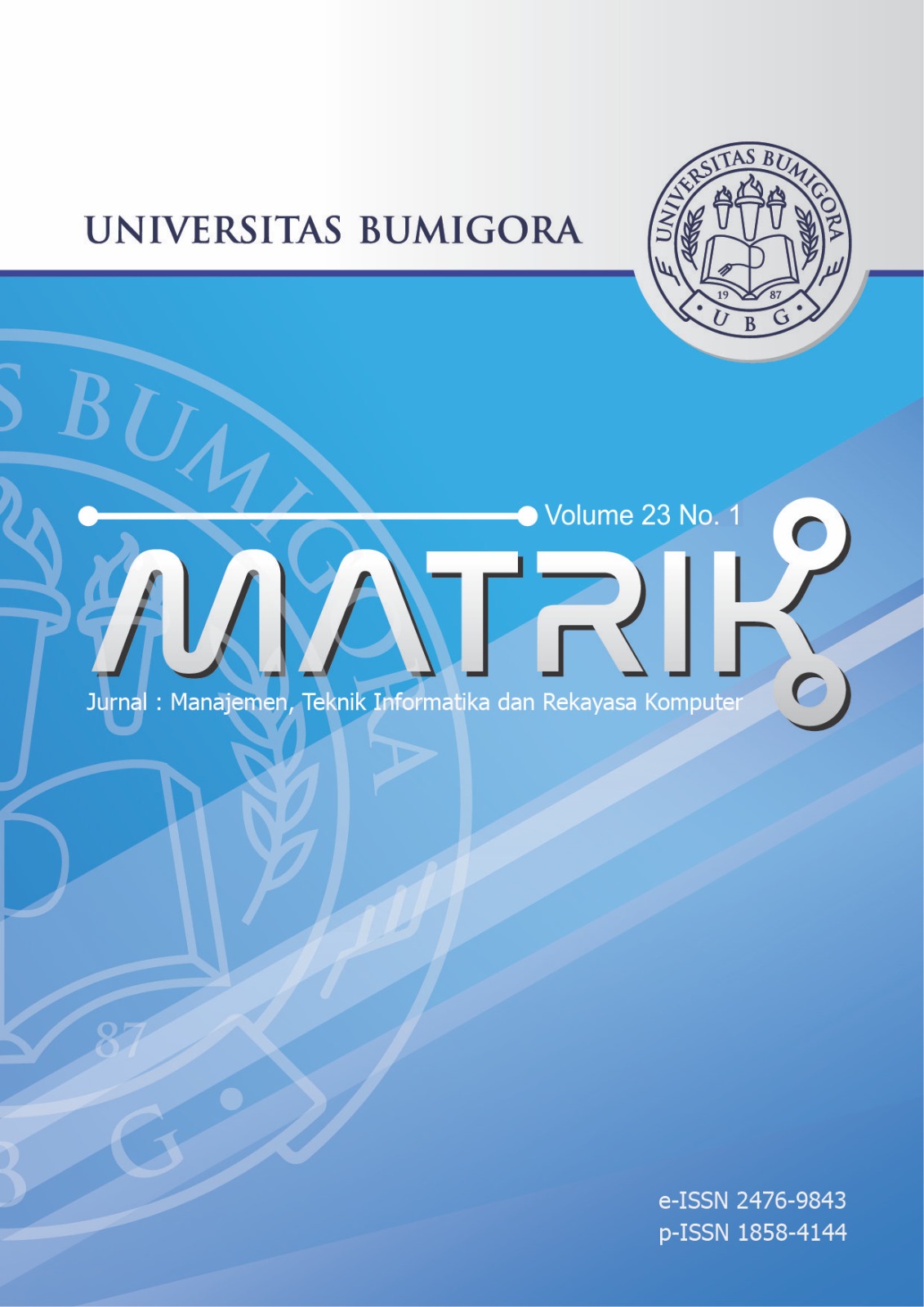Analyzing Sentiment with Self-Organizing Map and Long Short-Term Memory Algorithms
DOI:
https://doi.org/10.30812/matrik.v23i1.3332Keywords:
Long Short-Term Memory, Memory Algoritms, Self-Organizing Map, Sentiment AnalysisAbstract
This research delves into the impact of Chat Generative Pre-trained Transformer, one of Open Artificial Intelligence Generative Pretrained Transformer models. This model underwent extensive training on a vast corpus of internet text to gain insights into the mechanics of human language and its role in forming phrases, sentences, and paragraphs. The urgency of this inquiry arises from Chat Generative Pre-trained Transformer emergence, which has stirred significant debate and captured widespread attention in both research and educational circles. Since its debut in November 2022, Chat Generative Pre-trained Transformer has demonstrated substantial potential across numerous domains. However, concerns voiced on Twitter have centered on potential negative consequences, such as increased
forgery and misinformation. Consequently, understanding public sentiment toward Chat Generative Pre-trained Transformer technology through sentiment analysis has become crucial. The research’s primary objective is to conduct Sentiment Analysis Classification of Chat Generative Pre-trained Transformer regarding public opinions on Twitter in Indonesia. This goal involves quantifying and categorizing public sentiment from Twitter’s vast data pool into three clusters: positive, negative, or neutral. In the data clustering stage, the Self-Organizing Map technique is used. After the text data has been weighted and clustered, the next step involves using the classification technique with Long
Short-Term Memory to determine the public sentiment outcomes resulting from the presence of Chat Generative Pre-trained Transformer technology. Rigorous testing has demonstrated the robust performance of the model, with optimal parameters: relu activation function, som size of 5, num epoch som and num epoch lstm both at 128, yielding an impressive 95.07% accuracy rate.
Downloads
References
Artificial Intelligence-written research papers and the ethics of the large language models in scholarly publishing,â€
Journal of the Association for Information Science and Technology, vol. 74, no. 5, pp. 570–581, may 2023.
[Online]. Available: https://onlinelibrary.wiley.com/doi/full/10.1002/asi.24750https://onlinelibrary.wiley.com/doi/abs/10.1002/
asi.24750https://asistdl.onlinelibrary.wiley.com/doi/10.1002/asi.24750
[2] N. Shi, Q. Zeng, and R. Lee, “Language Chatbot-The Design and Implementation of English Language Transfer Learning Agent
Apps,†2020 IEEE 3rd International Conference on Automation, Electronics and Electrical Engineering, AUTEEE 2020, pp.
403–407, nov 2020.
[3] J. Kleesiek, Y. Wu, G. Stiglic, J. Egger, and J. Bian, “An Opinion on ChatGPT in Health CareWritten by Humans Only,â€
Journal of Nuclear Medicine, vol. 64, no. 5, pp. 701–703, apr 2023. [Online]. Available: https://jnm.snmjournals.org/content/
early/2023/04/13/jnumed.123.265687https://jnm.snmjournals.org/content/early/2023/04/13/jnumed.123.265687.abstract
[4] A. Faesal, A. Muslim, A. H. Ruger, and K. Kusrini, “Sentimen Analisis pada Data Tweet Pengguna Twitter
Terhadap Produk Penjualan Toko Online Menggunakan Metode K-Means,†MATRIK : Jurnal Manajemen, Teknik
Informatika dan Rekayasa Komputer, vol. 19, no. 2, pp. 207–213, may 2020. [Online]. Available: https:
//journal.universitasbumigora.ac.id/index.php/matrik/article/view/640
[5] I. Dergaa, K. Chamari, P. Zmijewski, and H. B. Saad, “From human writing to artificial intelligence generated text: examining
the prospects and potential threats of ChatGPT in academic writing,†Biology of Sport, vol. 40, no. 2, pp. 615–622, 2023.
[Online]. Available: https://doi.org/10.5114/biolsport.2023.125623
[6] Y. Akbar and T. Sugiharto, “Analisis Sentimen Pengguna Twitter di Indonesia Terhadap ChatGPT Menggunakan Algoritma
C4.5 dan Na¨ıve Bayes (Yuma Akbar 1*, Tri Sugiharto 2 ) Analisis Sentimen Pengguna Twitter di Indonesia Terhadap ChatGPT
Menggunakan Algoritma C4.5 dan Na¨ıve Bayes,†Jurnal Sains dan Teknologi, vol. 5, no. 1, pp. 115–122, 2023. [Online].
Available: https://doi.org/10.55338/saintek.v4i3.1368
[7] M. Farrokhnia, S. K. Banihashem, O. Noroozi, and A. Wals, “A SWOT analysis of ChatGPT: Implications for
educational practice and research,†Innovations in Education and Teaching International, apr 2023. [Online]. Available:
https://www.tandfonline.com/doi/abs/10.1080/14703297.2023.2195846
[8] N. N. Amir Sjarif, N. F. Mohd Azmi, S. Chuprat, H. M. Sarkan, Y. Yahya, and S. M. Sam, “SMS Spam Message Detection
using Term Frequency-Inverse Document Frequency and Random Forest Algorithm,†Procedia Computer Science, vol. 161, pp.
509–515, jan 2019.
[9] A. Patil, “Word Significance Analysis in Documents for Information Retrieval by LSA and TF-IDF using Kubeflow,†Lecture
Notes in Networks and Systems, vol. 209, pp. 335–348, 2022. [Online]. Available: https://link.springer.com/chapter/10.1007/
978-981-16-2126-0f g29
[10] F. Mikael Sinaga, P. Sirait, and A. Halim, “Optimization of SV-kNNC using Silhouette Coefficient and LMKNN for Stock Price
Prediction,†2020 3rd International Seminar on Research of Information Technology and Intelligent Systems, ISRITI 2020, pp.
326–331, dec 2020.
[11] D. I. Af’idah, D. Dairoh, S. F. Handayani, R. W. Pratiwi, and S. I. Sari, “Sentimen Ulasan Destinasi Wisata Pulau Bali
Menggunakan Bidirectional Long Short Term Memory,†MATRIK : Jurnal Manajemen, Teknik Informatika dan Rekayasa
Komputer, vol. 21, no. 3, pp. 607–618, jul 2022. [Online]. Available: https://journal.universitasbumigora.ac.id/index.php/
matrik/article/view/1402
[12] F. D. Ananda and Y. Pristyanto, “Analisis Sentimen Pengguna Twitter Terhadap Layanan Internet Provider Menggunakan
Algoritma Support Vector Machine,†MATRIK : Jurnal Manajemen, Teknik Informatika dan Rekayasa Komputer, vol. 20, no. 2,
pp. 407–416, may 2021. [Online]. Available: https://journal.universitasbumigora.ac.id/index.php/matrik/article/view/1130
[13] P. T. Putra, A. Anggrawan, and H. Hairani, “Comparison of Machine Learning Methods for Classifying User Satisfaction
Opinions of the PeduliLindungi Application,†MATRIK : Jurnal Manajemen, Teknik Informatika dan Rekayasa Komputer,
vol. 22, no. 3, pp. 431–442, jun 2023. [Online]. Available: https://journal.universitasbumigora.ac.id/index.php/matrik/article/
view/2860
[14] W. Riyadi and J. Jasmir, “Performance Prediction of Airport Traffic Using LSTM and CNN-LSTM Models,†MATRIK :
Jurnal Manajemen, Teknik Informatika dan Rekayasa Komputer, vol. 22, no. 3, pp. 627–638, jul 2023. [Online]. Available:
https://journal.universitasbumigora.ac.id/index.php/matrik/article/view/3032
[15] V. Raveendirarasa and C. R. Amalraj, “Sentiment Analysis of Tamil-English Code-Switched Text on Social Media Using Sub-
Word Level LSTM,†Proceedings of ICITR 2020 - 5th International Conference on Information Technology Research: Towards
the New Digital Enlightenment, dec 2020.
[16] M. K. Anam, B. N. Pikir, M. B. Firdaus, S. Erlinda, and A. Agustin, “Penerapan Na¨ıve Bayes Classifier, K-Nearest Neighbor
(KNN) dan Decision Tree untuk Menganalisis Sentimen pada Interaksi Netizen dan Pemeritah,†MATRIK : Jurnal Manajemen,
Teknik Informatika dan Rekayasa Komputer, vol. 21, no. 1, pp. 139–150, nov 2021.
[17] A. J. Makrufi, W. Fawwaz, and A. Maki, “Support vector machine with a firefly optimization algorithm for classification of
apple fruit disease,†MATRIK : Jurnal Manajemen, Teknik Informatika dan Rekayasa Komputer, vol. 22, no. 1, pp. 177–188,
nov 2022. [Online]. Available: https://journal.universitasbumigora.ac.id/index.php/matrik/article/view/2365
Analyzing
Downloads
Published
Issue
Section
How to Cite
Similar Articles
- Yuniansyah Yuniansyah, Andri Saputra, PENGEMBANGAN MULTIMEDIA PEMBELAJARAN UNTUK MATAKULIAH GRAFIK KOMPUTER MENGGUNAKAN METODE ADDIE , MATRIK : Jurnal Manajemen, Teknik Informatika dan Rekayasa Komputer: Vol. 17 No. 1 (2017)
- budi rahmani, Ruliah Ruliah, A Novel Algorithm of Distance Calculation Based-on Grid-Edge-Depth-Map and Gyroscope for Visually-Impaired , MATRIK : Jurnal Manajemen, Teknik Informatika dan Rekayasa Komputer: Vol. 22 No. 2 (2023)
- Andi Hary Akbar, Heri Wijayanto, I Wayan Agus Arimbawa, K-Means-Based Customer Segmentation with Domain-Specific Feature Engineering for Water Payment Arrears Management , MATRIK : Jurnal Manajemen, Teknik Informatika dan Rekayasa Komputer: Vol. 25 No. 1 (2025)
- Didih Rizki Chandranegara, Faras Haidar Pratama, Sidiq Fajrianur, Moch Rizky Eka Putra, Zamah Sari, Automated Detection of Breast Cancer Histopathology Image Using Convolutional Neural Network and Transfer Learning , MATRIK : Jurnal Manajemen, Teknik Informatika dan Rekayasa Komputer: Vol. 22 No. 3 (2023)
- Hartono, Khusnul Khotimah, Rokin Maharjan, Improving Detection Accuracy of Brute-Force Attacks on MariaDB Using Standard Isolation Forest: A Comparative Analysis with RotatedVariant , MATRIK : Jurnal Manajemen, Teknik Informatika dan Rekayasa Komputer: Vol. 25 No. 1 (2025)
- Imam Riadi, Abdul Fadlil, Muhammad Amirul Mu'min, OWASP Framework-based Network Forensics to Analyze the SQLi Attacks on Web Servers , MATRIK : Jurnal Manajemen, Teknik Informatika dan Rekayasa Komputer: Vol. 22 No. 3 (2023)
- Nella Rosa Sudianjaya, Chastine Fatichah, Segmentation and Classification of Breast Cancer Histopathological Image Utilizing U-Net and Transfer Learning ResNet50 , MATRIK : Jurnal Manajemen, Teknik Informatika dan Rekayasa Komputer: Vol. 24 No. 1 (2024)
- Mayadi Mayadi, Anthony Anggrawan, Pengembangan Sistem Informasi Pemantauan Harga Beras dan Gabah dengan Short Message Gateway , MATRIK : Jurnal Manajemen, Teknik Informatika dan Rekayasa Komputer: Vol. 21 No. 2 (2022)
- William Barkem, Jeckson Sidabutar, Digital Forensic Analysis of WhatsApp Business Applications on Android-Based Smartphones Using NIST , MATRIK : Jurnal Manajemen, Teknik Informatika dan Rekayasa Komputer: Vol. 22 No. 3 (2023)
- Budi Sumanto, Salima Nurrahma, Comparison of Random Forest Support Vector Machine and Passive Aggressive Models on E-nose-Based Aromatic Rice Classification , MATRIK : Jurnal Manajemen, Teknik Informatika dan Rekayasa Komputer: Vol. 24 No. 3 (2025)
You may also start an advanced similarity search for this article.


.png)












